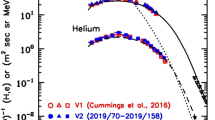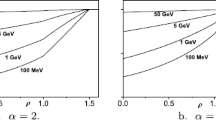Abstract
The significance of external influences on the environment of Earth and its atmosphere has become evident during recent years. Especially, on time scales of several hundred years, the cosmogenic isotope concentration during the Wolf-, Spoerer-, Maunder- and Dalton-Minimum indicates an increased cosmic ray flux. Because these grand minima of solar activity coincide with cold periods, a correlation of the Earth climate with the cosmic ray intensities is plausible. Any quantitative study of the effects of energetic particles on the atmosphere and environment of the Earth must address their transport to Earth and their interactions with the Earth’s atmosphere including their filtering by the terrestrial magnetosphere. The first problem is one of the fundamental problems in modern cosmic ray astrophysics, and corresponding studies began in the 1960s based on Parker’s cosmic ray modulation theory taking into account diffusion, convection, adiabatic deceleration, and (later) the drift of energetic particles in the global heliospheric magnetic field. It is well established that all of these processes determining the modulation of cosmic rays are depending on parameters that are varying with the solar magnetic cycle. Therefore, the galactic cosmic ray intensities close to Earth is the result of a complex modulation of the interstellar galactic spectrum within the heliosphere. The modern view of this cosmic ray modulation is summarized in our contribution.
Similar content being viewed by others
References
Beatty, J. J., Garcia-Munoz, M., and Simpson, J. A.: 1985, ‘The cosmic-ray spectra of H-1, H-2, and He-4 as a test of the origin of the hydrogen superfluxes at solar minimum modulation’, Astrophys. J. 294, 455–462.
Beer, J., Vonmoos, M., and Muscheler, R.: 2006, ‘Solar variability over the past several millenia ’, Space Sci. Rev., this volume, doi: 10.1007/s11214-006-9047-4.
Belov, A.: 2000, ‘Large scale Modulation: View From the Earth ’, Space Sci. Rev. 93, 79–105.
Belov, A. V., Eroshenko, E. A., Heber, B., Yanke, V. G., Raviart, A., Müller-Mellin, R., and Kunow, H.: 2003, ‘Latitudinal and radial variation of >2 GeV/n protons and alpha-particles at solar maximum: ULYSSES COSPIN/KET and neutron monitor network observations’, Annales Geophysicae 21, 1295–1302.
Bieber, J. W., Matthaeus, W. H., Shalchi, A., and Qin, G.: 2004, ‘Nonlinear guiding center theory of perpendicular diffusion: General properties and comparison with observation’, Geophys. Res. Lett. 31, doi:10.1029/2004GL020007.
Burger, R. A., Hattingh, M., and Bieber, J. W.: 1997, ‘The effect of magnetic helicity on the propagation of galactic cosmic rays’, Adv. Space Res. 19, 897–900.
Burlaga, L. F., Perko, J., and Pirraglia, J.: 1993, ‘Cosmic-ray modulation, merged interaction regions, and multifractals’, Astrophys. J. 407, 347–358.
Caballero-Lopez, R. A., Moraal, H., McCracken, K. G., and McDonald, F. B.: 2004, ‘The heliospheric magnetic field from 850 to 2000 AD inferred from 10Be records’, J. Geophys. Res. 109, doi:10.1029/2004JA010633.
Cane, H., Wibberenz, G., Richardson, I. G., and von Rosenvinge, T. T.: 1999, ‘Cosmic ray modulation and the solar magnetic field ’, Geophys. Res. Lett. 26, 565–568.
Decker, R. B., Krimigis, S. M., Roelof, E. C., Hill, M. E., Armstrong, T. P., Gloeckler, G., Hamilton, D. C., and Lanzerotti, L. J.: 2005, ‘Voyager 1 in the Foreshock, Termination Shock, and Heliosheath’, Science 309, 2020–2024.
Fahr, H. J., Kausch, T., and Scherer, H.: 2000, ‘A 5-fluid hydrodynamic approach to model the solar system-interstellar medium interaction’, Astron. Astrophys. 357, 268–282.
Ferreira, S. E. S., and Potgieter, M. S.: 2004, ‘Long-Term Cosmic-Ray Modulation in the Heliosphere’, Astrophys. J. 603, 744–752.
Fichtner, H.: 2001, ‘Anomalous Cosmic Rays: Messengers from the outer heliosphere’, Space Sci. Rev. 95, 639–754.
Fisk, L. A.: 1996, ‘Motion of the footpoints of heliospheric magnetic field lines at the Sun: Implications for recurrent energetic particle events at high heliographic latitudes’, J. Geophys. Res. 101, 15,547–15,554.
Fisk, L. A., Kozlovsky, B., and Ramaty, R.: 1974, ‘An Interpretation of the Observed Oxygen and Nitrogen Enhancements in Low-Energy Cosmic Rays’, Astrophys. J. Lett. 190, L35.
Fujii, Z., and F. B. McDonald: 2005, ‘The spatial distribution of galactic and anomalous cosmic rays in the heliosphere at solar minimum’, Adv. Space Res. 35, 611–616.
Garcia-Munoz, M., Mason, G. M., and Simpson, J. A.: 1973, ‘A new test for solar modulation theory: The 1972 May-July low-energy galactic cosmic-ray proton and helium spectra’, Astrophys. J. Lett. 182, L81.
Gurnett, D. A., Kurth, W. S., and Stone, E. C.: 2003, ‘The return of the heliospheric 2–3 kHz radio emission during solar cycle 23’, Geophys. Res. Lett. 30, 8–1.
Heber, B. and Potgieter, M. S.: 2000, ‘Galactic cosmic ray observations at different heliospheric latitudes’, Adv. Space Res. 26, 839–852.
Heber, B. and Marsden, R. G.: 2001, ‘Cosmic Ray Modulation over the Poles at Solar Maximum: Observations.’, Space Sci. Rev. 97, 309–319.
Heber, B., Dröge, W., Ferrando, P., Haasbroek, L., Kunow, H., Müller-Mellin, R., Paizis, C., Potgieter, M., Raviart, A., and Wibberenz, G.: 1996a, ‘Spatial variation of >40 MeV/n nuclei fluxes observed during the Ulysses rapid latitude scan’, Astron. Astrophys. 316, 538–546.
Heber, B., Dröge, W., Kunow, H., Müller-Mellin, R., Wibberenz, G., Ferrando, P., Ravart, A., and Paizis, C.: 1996b, ‘Spatial variation of >106 MeV proton fluxes observed during the Ulysses rapid latitude scan: Ulysses COSPIN/KET results’, Geophys. Res. Lett. 23, 1513–1516.
Heber, B., Ferrando, P., Raviart, A., Wibberenz, G., Müller-Mellin, R., Kunow, H., Sierks, H., Bothmer, V., Posner, A., Paizis, C., and Potgieter, M. S.: 1999, ‘Differences in the temporal variation of galactic cosmic ray electrons and protons: Implications from Ulysses at solar minimum’, Geophys. Res. Lett. 26, 2133–2136.
Heber, B., Sarri, G., Wibberenz, G., Paizis, C., Ferrando, P., Raviart, A., Posner, A., Müller-Mellin, R., and Kunow, H.: 2003, ‘The Ulysses fast latitude scans: COSPIN/KET results’, Annales Geophysicae 21, 1275–1288.
Hoeksema, J.: 1995, ‘The large-scale structure of the heliospheric current sheet during the ULYSSES epoch’, Space Sci. Rev. 72, 137–148.
Jokipii, J. R., Levy, E. H., and Hubbard, W. B.: 1977, ‘Effects of particle drift on cosmic ray transport, I. General properties, application to solar modulation’, Astrophys. J. 213, 861–868.
Leipold, M., Fichtner, H., Heber, B., Groepper, P., Lascar, S., Burger, F., Eiden, M., Niederstadt, T., Sickinger, C., Herbeck, L., Dachwald, B., and Seboldt, W.: 2003, ‘Heliopause Explorer - a sailcraft mission to the outer boundaries of the solar system’, In: ESA SP-542: Low-Cost Planetary Missions. pp. 367–375.
Liewer, P. C., Mewaldt, R. A., Ayon, J. A., and Wallace, R. A.: 2000, ‘NASA’s Interstellar Probe Mission’, In: AIP Conf. Proc. 504: Space Technology and Applications International Forum. p. 911.
Marsden, R. C., and Wenzel, K. P.: 1981, ‘The International Solar Polar Mission (ISPM)’, In: ESA SP-164: Solar System and Its Exploration. pp. 51–59.
McCracken, K. G., McDonald, F. B., Beer, J., Raisbeck, G., and Yiou, F.: 2004, ‘A phenomenological study of the long-term cosmic ray modulation, 850-1958 AD’, J. Geophys. Res. 109, doi:10.1029/2004JA010685.
McKibben, R. B., Connell, J. J., Lopate, C., Simson, J. A., and Zhang, M.: 1996, ‘Observations of galactic cosmic rays and the anomalous helium during the Ulysses passage from the south pole to the north pole’, Astron. Astrophys. 316, 547.
McKibben, R. B., Connell, J. J., Lopate, C., Zhang, M., Anglin, J. D., Balogh, A., dalla, S., Sanderson, T. R., Marsden, R. G., Hofer, M. Y., Kunow, H., Posner, A., and Heber, B.: 2003, ‘Ulysses COSPIN observations of cosmic rays and solar energetic particles from the South Pole to the North Pole of the Sun during solar maximum’, Annales Geophysicae 21, 1217–1288.
Moraal, H.: 1993, ‘Cosmic ray modulation studies in the outer heliosphere’, Nuclear Physics B Proceedings Supplements 33, 161–178.
Ndiitwani, D. C., Ferreira, S. E. S., Potgieter, M. S., and Heber, B.: 2005, ‘Modelling cosmic ray intensities along the Ulysses trajectory’, Annales Geophysicae 23, 1061–1070.
Parhi, S., Burger, R. A., Bieber, J. W., and Matthaeus, W. H.: 2001, ‘Challenges for an ab initio theory of cosmic ray modulation’, In: Proceedings of the ICRC 2001. pp. 3670–3673.
Parker, E. N.: 1958, ‘Dynamics of the Interplanetary gas and magnetic fields’, Astrophys. J. 128, 664.
Parker, E. N.: 1963, Interplanetary Dynamical Processes, New York: Wiley and Sons.
Parker, E. N.: 1965, ‘The passage of energetic particles through interplanetary space’, Planet. Sp. Sc. 13, 9–49.
Potgieter, M.: 1984, ‘The modulation of galactic cosmic rays as described by a three-dimensional drift model’, Ph.D. thesis, Potchefstroom University of CHE, South Africa.
Potgieter, M. S.: 1998, ‘The modulation of galactic cosmic rays in the heliosphere: Theory and models’, Space Sci. Rev. 83, 147–158.
Potgieter, M. S., and le Roux, J. A.: 1992, ‘The simulated features of heliospheric cosmic-ray modulation with time-dependent drift model I. General effects of the changing neutral sheet over the period 1985-1990’, Astrophys. J. 386, 336–346.
Potgieter, M., and Ferreira, S. E. S.: 2001, ‘Modulation of cosmic rays in the heliosphere over 11 and 22 year cycles: A modelling perspective’, Adv. Space Res. 27, 481–492.
Reinecke, J. P. L. and Potgieter, M. S.: 1994, ‘An explanation for the difference in cosmic ray modulation at low and neutron monitor energies during consecutive solar minimum periods’, J. Geophys. Res. 99, 14,761–14, 768.
Scherer, K., and Fichtner, H.: 2004, ‘Constraints on the heliospheric magnetic field variation during the Maunder Minimum from cosmic ray modulation modelling’, Astron. Astrophys. 413, L11–L14.
Scherer, K., and Ferreira, S. E. S.: 2005, ‘A heliospheric hybrid model: hydrodynamic plasma flow and kinetic cosmic ray transport’, Astrophys Space Sci. Transactions 1, 17–27.
Scherer, K., Fahr, H.-J., Fichtner, H., and Heber, B.: 2004, ‘Long-Term Modulation of Cosmic Rays in the Heliosphere and its Influence at Earth’, sol. phys. 224, 305–316.
Shalchi, A., and Schlickeiser, R.: 2004, ‘Quasilinear perpendicular diffusion of cosmic rays in weak dynamical turbulence’, Astron. Astrophys. 420, 821–832.
Shalchi, A., and Schlickeiser, R.: 2005, ‘Evidence for the Nonlinear Transport of Galactic Cosmic Rays’, Astrophys. J. Lett. 626, L97–L99.
Simpson, J. A.: 1983, ‘Introduction to the galactic cosmic radiation’, In: NATO ASIC Proc. 107: Composition and Origin of Cosmic Rays. pp. 1–24.
Simpson, J., it et al.: 1992, ‘The Ulysses Cosmic-Ray and Solar Particle Investigation’, Astron. Astrophys. Suppl. 92, 365–399.
Simpson, J., Zhang, M., and Bame, S.: 1996, ‘A solar polar north-south asymmetry for cosmic ray propagation in the heliosphere: the Ulysses pole-to-pole rapid transit’, Astrophys. J. Lett. 465, L69.
Snyder, C. W., and Neugebauer, M.: 1963, ‘Direct Observations of the Solar Wind by the Mariner II spacecraft’, Solar Particles and Sun-Earth Relations. Proceedings from the 8th International Cosmic Ray Conference, Volume 1, p. 210 1, 210.
Stone, E. C., Cummings, A. C., McDonald, F. B., Heikkila, B. C., Lal, N., and Webber, W. R.: 2005, ‘Voyager 1 Explores the Termination Shock Region and the Heliosheath Beyond’, Science 309, 2017–2020.
Strong, A. W.: 2001, ‘Signatures of Energetic Protons and Electrons in the Galaxy’, Space Sci. Rev. 99, 167–176.
Vasyliunas, V. M., and Siscoe, G. L.: 1976, ‘On the flux and the energy spectrum of interstellar ions in the solar system’, J. Geophys. Res. 81, 1247–1252.
Webber, W. R.: 1983, ‘Cosmic ray electrons and positrons — a review of current measurements and some implications’, In: NATO ASIC Proc. 107: Composition and Origin of Cosmic Rays. pp. 83–100.
Webber, W. R.: 1998, ‘A new estimate of the local interstellar energy density and ionization rate of galactic cosmic cosmic rays’, Astrophys. J. 506, 329–334.
Author information
Authors and Affiliations
Corresponding author
Rights and permissions
About this article
Cite this article
Heber, B., Fichtner, H. & Scherer, K. Solar and Heliospheric Modulation of Galactic Cosmic Rays. Space Sci Rev 125, 81–93 (2006). https://doi.org/10.1007/s11214-006-9048-3
Received:
Accepted:
Published:
Issue Date:
DOI: https://doi.org/10.1007/s11214-006-9048-3




